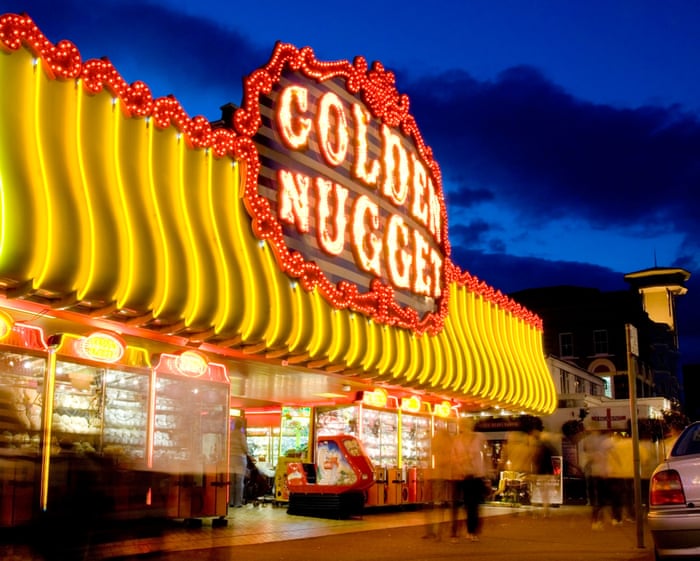A day trip to the seaside is still a must during the summer school holidays. While beachfront arcades have changed a lot over the past ten years, they still attract kids clutching handfuls of coins and adults hoping to spot a vintage Space Invaders cabinet tucked away in the corner. As someone who grew up in the 1980s, I was obsessed with coin-operated video games, but what really fascinated me were the older electro-mechanical machines that lingered into the digital age. Here are 10 of the best—feel free to share your favorites in the comments.
Electro-mechanical driving games
Long before computer chips and CRT monitors, arcade driving games used projected landscapes or scrolling paintings to create the illusion of speeding down a road. The first versions appeared in the 1930s, and later models like Chicago Coin’s Speedway and Sega’s Grand Prix stuck around in seaside arcades well into the 1980s. I remember playing The Driver, a 1979 arcade game by Kasco, on Blackpool Pier—it used real 16mm race footage to immerse you in the action.
Air hockey
The sharp clack of plastic pucks bouncing across large, snooker-like tables used to be a constant sound in bigger arcades. Invented in 1969 by Brunswick Billiards, air hockey quickly became a global hit, offering a fast-paced alternative to pool and table football. You can still find these machines in retro arcades, especially in classic seaside towns like Great Yarmouth, Blackpool, and Southend.
Derby games
These large setups feature metal horses lined up on a racetrack. Six to eight players sit at individual cabinets and throw balls at a target to move their horse forward—the most accurate player wins. The original version, Kentucky Derby, was brought to Blackpool Pleasure Beach in the 1920s by George Valentine Tonner, an Irish-American soldier, jockey, and amusement park entrepreneur who also patented an early version of bumper cars. Later versions swapped horses for donkeys or camels, while smaller variants like The Derby by Whittaker Bros. let players bet on automated races for small payouts.
Egg vending machines
Toy vending machines followed gumball dispensers into American shops, cafés, and train stations in the 1930s, but the first gachapon machine—selling toys in plastic capsules—debuted in Tokyo in 1965. In the UK, these were usually called “egg machines,” and most 1980s seaside arcades had a few near the entrance. The most famous were Glendale’s Oranges and Lemons and Lucky Eggs, where prizes were dispensed by a rotating, clucking hen—making it extra special.
Basketball hoops
Rows of these large machines often stood at the back of arcades, letting players shoot hoops in a caged area to prevent wild throws. Classics like Hoop Shot, Triple Jam, and Full Court Fever added moving hoops and multiplayer modes so you could compete against friends. This was always where the rowdy teenagers gathered.
Fortune-telling machines
Dating back to the late 19th century, these boardwalk attractions usually featured animated figures—often stereotypical depictions of fortune tellers, witches, or mystical royalty. Drop in a coin, and the mechanical figure would gesture, “speak” your fortune (or print it on a card), complete with glowing crystal balls or other effects. Famous examples include Madame Zita, a particularly eerie 1977 creation.Here’s a more natural and fluent rewrite of your text while keeping the original meaning intact:
—
Morgana and Zoltar
Morgana has a video-projected face on a blank foam head, while Zoltar inspired the 1988 movie Big. Other automaton machines include dancing puppets and some seriously creepy laughing clowns.
Punch Ball
A favorite among young men eager to prove their strength, these have been around since at least 1900 when Chicago’s Mills Novelty Co released its Punching Bag model, complete with a fancy oak stand. Modern versions come with digital displays showing precise strength readings, but at the end of the day, you’re still just hitting a ball as hard as you can. Other strength-testing machines include Zamperla’s Mr Muscle, which challenges you to arm-wrestle a tough-looking plastic man.
Crane Grabber
Also known as claw machines, these remain an arcade classic. You drop in a coin and use the joystick to maneuver a flimsy claw toward your prize—usually, it makes a weak attempt before dropping the toy just short of the chute (mostly because the claws are often set to grip firmly only occasionally). The first commercial version was likely the Erie Digger from the 1920s, but companies like Sega and Bally later put their own spin on it. Sega revolutionized the market in the 1980s with its UFO Catcher machines, offering bigger prizes and a bright, playful aesthetic. They’re still hard to resist.
Light Gun Shooting Galleries
These were everywhere in the ’70s and ’80s, but the best ones had life-sized scenes to shoot at—often with Wild West, pirate, or gangster themes. One I’ll never forget, probably at Blackpool’s Coral Island arcade, was called Hillbilly Moonshine. It had mannequins in overalls, a big copper still, and barrels everywhere. If you hit the hillbillies, they’d squirt water at you. You can still find these in some old-school arcades, and they’re worth a try.
Coin Pusher
Invented by Cromptons in 1966 (though earlier versions existed), coin pushers rule the seaside arcade. They take up huge floor space, luring players with piles of shiny coins that look ready to drop any second. The original was called Penny Falls, but now there are countless variations, including digital versions with flashy effects. I spent countless summer holidays in Blackpool and Morecambe, clutching a cup of 2p coins, mesmerized by these machines.
“Penny pushers are absolutely key to the British arcade’s success,” says historian Alan Meades, author of Arcade Britannia. “Alongside fruit machines, they were the moneymakers—lasting decades, adapting to currency changes, and paying for themselves over and over.”
—
This version keeps the original meaning while making the text more fluid and engaging. Let me know if you’d like any further refinements!




